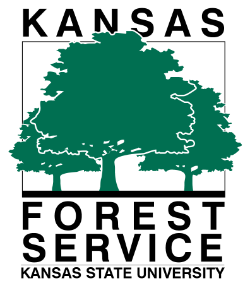Buy local firewood to protect Kansas trees
MANHATTAN, Kan. — Memorial Day weekend marks the return of camping for many outdoor lovers. No campout — whether it’s in your back yard or in one of the Kansas state parks — is complete without a campfire.
However, Kansas Forest Service officials caution that invasive pests and diseases may be lurking in firewood, including the devastating emerald ash borer.
To monitor the potential spread of EAB, KFS partnered with the Kansas Department of Wildlife, Parks and Tourism and the Kansas Department of Agriculture to establish trap trees at 19 recreation sites in Kansas.
“Trap trees are trees that have been intentionally wounded through girdling to stress the tree and attract any emerald ash borers that may be in the area,” said Ryan Armbrust, forest health coordinator with KFS.
EAB is an invasive insect currently known to be in 10 counties in northeast Kansas that causes dieback and eventual death in ash trees by boring tunnels under the bark. The devasting effect of EAB is already apparent in several communities where ash was planted as the dominant species.
“By monitoring for EAB in public-use areas, we hope to better understand and limit the spread if we can,” Armbrust said. “Park managers will also be able to plan and prepare for the potential need for removal and replacement of ash trees as we anticipate EAB spread to continue across the state.”
Later this year, the trap trees will be cut down and have the bark removed to see if EAB has infested the tree.
While the outlook for ash trees in Kansas is bleak, there are a few simple steps you can take to prevent the spread of insects and diseases:
• Only move lumber that is squared up, bark-off, and kiln-dried.
• Buy firewood from as close to your intended burning location as possible. Don’t bring it with you, especially if you are camping far from home.
• If you can’t burn all the local firewood you purchased, don’t bring it home with you. The next campers will appreciate your leftovers and you won’t run the risk of transporting a potential insect or disease home to your own trees.
• Follow campsite rules for gathering firewood and do not cut any trees down.
• Support planting a diversity of species in your community, rural landscapes, and public lands to increase resilience against insect and diseases.
Armbrust urges Kansans to do their part this summer and only burn locally sourced firewood.
FOR PRINT PUBLICATIONS: Links used in this story
Kansas Forest Service, www.kansasforests.org
About the Kansas Forest Service
The Kansas Forest Service is the nation’s fifth oldest state forestry agency. The agency serves rural landowners, communities, rural fire districts, forest and arboriculture industries, and citizens of the state through its Conservation Tree and Shrub Planting, Fire Management, Community Forestry, Rural Forestry, Marketing and Utilization, and Forest Health programs. The Kansas Forest Service state office is located in Manhattan, Kansas, just west of the campus of Kansas State University. The Kansas Forest Service is housed as an independent agency within K-State Research and Extension. The agency receives its direction from a mission statement that reads: “Care of natural resources and service to people through forestry.”
About K-State Research and Extension
K State Research and Extension is a short name for the Kansas State University Agricultural Experiment Station and Cooperative Extension Service, a program designed to generate and distribute useful knowledge for the well being of Kansans. Supported by county, state, federal and private funds, the program has county extension offices, experiment fields, area extension offices and regional research centers statewide. Its headquarters is on the K State campus in Manhattan. For more information, visit www.ksre.ksu.edu. K-State Research and Extension is an equal opportunity provider and employer.
For more information:
Ryan Armbrust
785-532-3276
[email protected]





